Alcohol and Drug Use in Ageing Populations
NCETA is assisting specialist and generalist health and welfare workers to better prevent, assess and respond to the needs of older people experiencing, or at risk of experiencing, alcohol and other drug (AOD) related harm. Longer life expectancy, changing patterns of AOD use and differing expectations of current and future generations of older people will all impact on future AOD service delivery. To-date comparatively little attention has been directed to the needs of older people and AOD use and, as a result, AOD use patterns and problems among older Australians have been under-researched and are not well understood. However, this is quickly becoming an emerging area of interest requiring greater resources, improved understanding, changes in service provision.
When addressing AOD issues among older people, attention will also need to be directed to the different needs of the various age groups. Those aged 55-65, 65-80 and 80+ may have different life experiences related to the year they were born, the cohort they grew up with and world events during their formative and later years. Similarly, those from different cultural backgrounds may have specific needs as will Aboriginal and Torres Strait Islander People. Hence, the term ‘older people’ should not be interpreted to mean a large single undifferentiated group. Sensitive responses are required to address the needs of the very diverse population groups that fall under the broad umbrella heading of ‘older people’.
The under-recognition of this important area will constitute significant challenges for services into the future.
NCETA Resources
Preventing and Reducing Alcohol- and Other Drug-Related Harm among Older People: A practical guide for health and welfare professionals
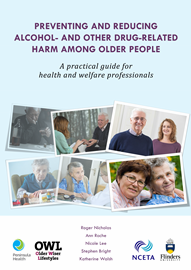 |
NCETA, in collaboration with Peninsula Health, Victoria produced the Preventing and Reducing Alcohol- and Other Drug-Related Harm among Older People: A practical guide for health and welfare professionals to assist specialist and generalist clinicians to assess and respond to the range of AOD-related harms impacting older people. It provides guidance to:
The resource was launched on 26 November 2015. |
The Conversation
Read the article 'Older Australians' drinking on the rise and they don't know the risks' published in The Conversation.
Grey Matters: Preventing and responding to alcohol and other drug problems among older Australians Information Sheets
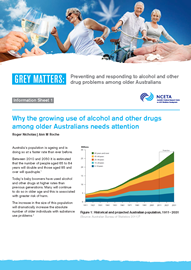 |
|
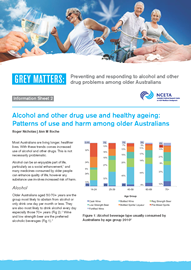 |
|
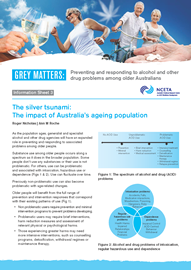 |
|
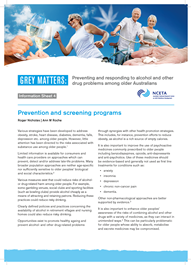 |
|
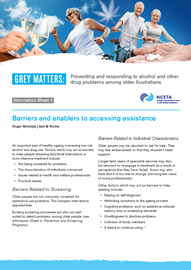 |
|
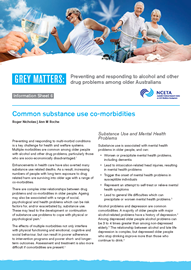 |
|
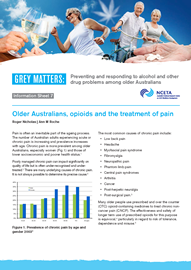 |
|
Grey Matters: Preventing and responding to alcohol and other drug problems among older Australians Reference List |
|
|
Information Sheet 1: References
Information Sheet 2: References
Information Sheet 3: References
Information Sheet 4: References
Information Sheet 5: References
Information Sheet 6: References
Information Sheet 7: References
|
|
Other Research & Resources
Research
Wilkinson, C., & Dare, J. (2014). Shades of grey: The need for a multi-disciplinary approach to research investigating alcohol and ageing. Journal of Public Health Research, 3, 180.
Wilkinson, C., Dare, J., Waters, S., Allsop, S., & McHale, S. (2012). An exploration of how social context and type of living arrangement are linked to alcohol consumption amongst older Australians. Canberra: Foundation for Alcohol Research and Education.
Australian Drug Foundation. (2011). Older people and alcohol and other drugs. DrugInfo. Newsletter of the Australian Drug Foundation’s DrugInfo Service, 9(4).
Hunter, B. (2011). Older people and alcohol and other drugs. Melbourne: Australian Drug Foundation.
Kelsall, J., Parkes, P., Watson, M., Madden, A., & Byrne, J. (2011). Double Jeopardy: Older injecting opioid users in Australia. Canberra: Australian Injecting and Illicit Drug Users League.
Royal College of Psychiatrists. (2011). Our invisible addicts. London: Royal College of Psychiatrists.
Wadd, S., Lapworth, K., Sullivan, M., Forrester, D., & Galvani, S. (2011). Working with older drinkers. Bedford: Tilda Goldberg Centre, University of Bedfordshire.
European Monitoring Centre for Drugs and Drug Addiction (EMCDDA). (2010).Treatment and care for older drug users. Luxembourg: Publications Office of the European Union.
Hunter, B., & Lubman, D. (2010). Substance misuse: Management in the older population. Australian Family Physician, 39(10), 738-741.
Gossop, M. (2008). Substance use among older adults: A neglected problem. Lisbon, Portugal: European Monitoring Centre for Drugs and Drug Addiction.
Resources
Duggan, M. (2014). Wiser and older: Safer drinking throughout life. Tasmania: Drug Education Network.
Nicholas, R., Roche, A., & Lee, N. (2014, November 9-12). Fifty shades of grey: Alcohol and other drug problems among older Australians - barriers to treatment. Paper presented at APSAD Scientific Conference, Adelaide Convention Centre, South Australia.
Draper, B. (2013, March 15–17). If You Can Remember the 60s You Weren’t There…..Older People and Substance Misuse. Paper presented at The Medicine in Addiction Conference, Sydney, New South Wales.
Australian Government Department of Veterans’ Affairs. (2009). The right mix 1. Your health and alcohol. Canberra: Australian Government Department of Veterans’ Affairs.
Australian Government Department of Veterans’ Affairs. (2009). The right mix 2. Guidelines for alcohol consumption. Canberra: Australian Government Department of Veterans’ Affairs.
Australian Government Department of Veterans’ Affairs. (2009). The right mix 3. Alcohol screen audit. Canberra: Australian Government Department of Veterans’ Affairs.
Haber, P., Lintzeris, N., Proude, E., & Lopatko, O. (2009). Guidelines for the Treatment of Alcohol Problems. Canberra: Australian Government Department of Health and Ageing.
Substance Abuse and Mental Health Services Administration. (1998). Substance abuse among older adults: Treatment Improvement Protocol (TIP) Series, No. 26. Rockville, MD: Substance Abuse and Mental Health Services Administration.
Matua Raki. The art of engagement. Older people and AOD. Wellington: Matua Raki: The National Addiction Workforce Development Centre.
Matua Raki. What does it mean for practice? Strategies for working with older people. Wellington: Matua Raki: The National Addiction Workforce Development Centre.
Matua Raki. Assessment and screening issues for older adults. Using the method from the Alcohol Related Problems Survey (ARPS). Wellington: Matua Raki: The National Addiction Workforce Development Centre.
Matua Raki. Working with Older People. Cognitive Impairment and Compulsory Treatment. Wellington: Matua Raki: The National Addiction Workforce Development Centre.
Matua Raki. Alcohol/drug interactions. Wellington: Matua Raki: The National Addiction Workforce Development Centre.